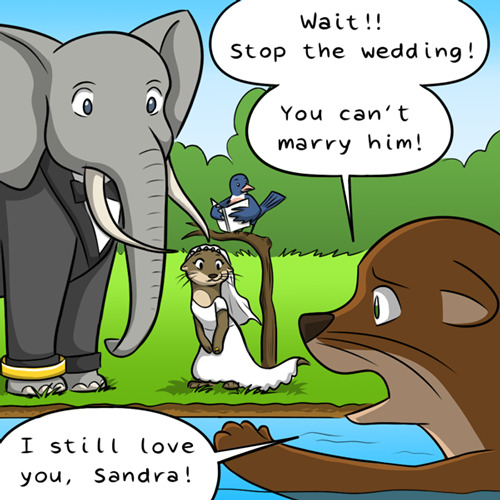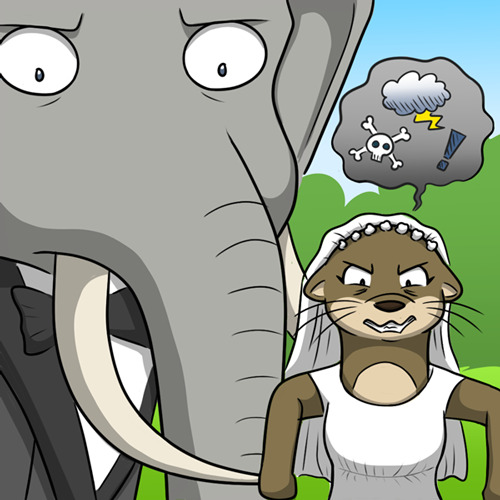Don't wanna be here? Send us removal request.
Video
This heart-warming Disneyland Paris spot features a sweet CG duck who simply adores Donald Duck. It’s the perfect cure for post-Christmas blues!!!
225K notes
·
View notes
Video
Beautiful zoetrope animation , I couldn't see any information scrolling back but this kit is by kevin Holmes. It looks like its pre-order/kickstarter - http://4-mation.co.uk
281K notes
·
View notes
Photo
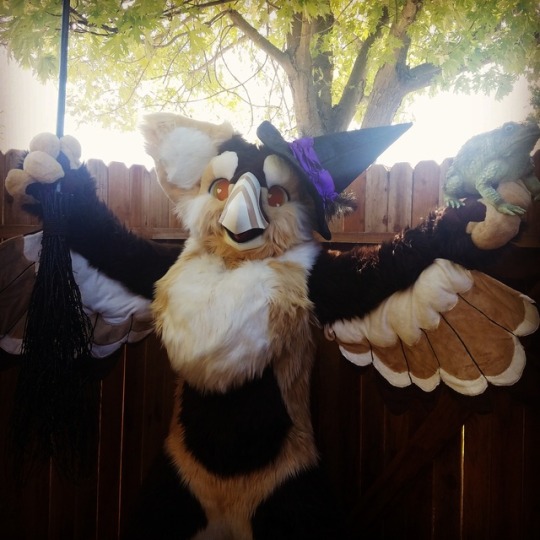
Weirdly enough, that broom is the only way Kahlúa can fly!
87 notes
·
View notes
Photo

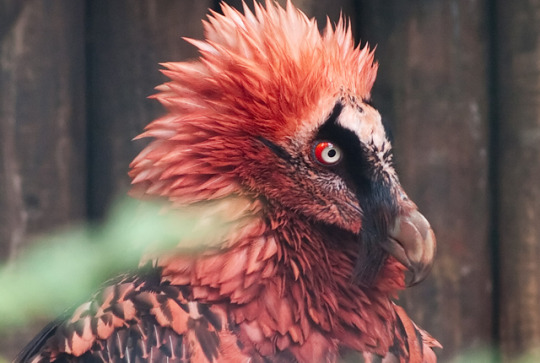


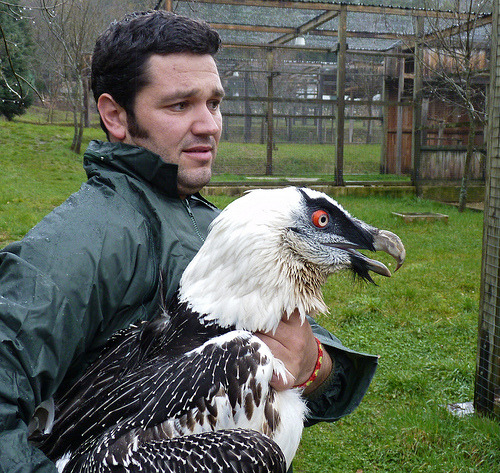


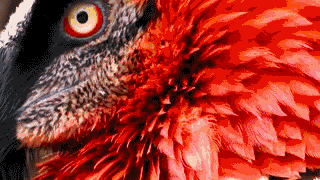

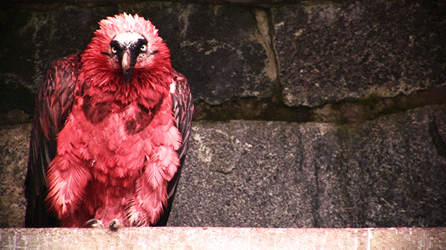
My all time favorite animal. The red-bearded vulture.
The bearded vulture, or lammergeier, lives on a steady diet of bones (more specifically the marrow) and dyes its own feathers blood red.
Bearded vultures come in various shades, from pure white to orange-red. Soils stained with iron oxide give the birds their fiery appearance. Lammergeiers apply the dirt with their claws and then preen for about an hour to ensure a bright orange/red glow. They are also attracted to other red things, like leaves and red wood. Captive birds also partake in this behavior, which suggests the activity is instinctual, not learned.
The soil doesn’t have any practical purposes; it certainly doesn’t make for good camouflage (though the birds have no natural predators anyway). Scientists have noticed that the birds’ age and size are directly correlated to the intensity of color. It is theorized that the hue is a status symbol. More soiled feathers indicates that the lammergeier had the time and resources to find an adequate place to bathe; the brightest-colored vultures should have the most territory and knowledge of their surroundings. Interestingly, these baths are done in secret, so most of the information gathered has been through spying on captive birds.
Bearded Vultures are most commonly monogamous, and breed once a year. Sometimes, especially in certain areas of Spain and France, bachelor lammergeiers will join a pre-existing couple to create a polyandrous trio. Females accept secondary mates because it increases the chances of producing offspring and doubles her protection. The birds usually don’t lay more than three eggs, so they can use all the help they can get.
These giant birds can grow up to 4 feet tall. They have a wingspan between 7 and 9 feet and usually weigh around 10 to 15 pounds.
In other words, this bird is awesome and I love it forever.
117K notes
·
View notes
Photo

So, so many works I’ve read could be vastly improved with tightening and shaving of superfluous words. Wordiness is an easy stumbling block, as we’re used to how we talk. We’re used to how others (long ago) wrote. But times change, my friend, and so do expectations of the writer. We don’t get paid by the word in fiction. So show your smarts and say as much as you can with as much power as you can in as few words as possible.
Here are a few things you can cut without reserve to help shorten your story right now. And as you catch yourself using these words in your next draft, hit that backspace before you finish the sentence! It’s okay if you already have. You can go delete them now. No one will ever know.

Moment/Second/Minute
It’s so tempting. I am guilty of using this word like fertilizer in my first drafts. But most of the time, these words aren’t needed at all. They add nothing.
He sat down for a moment, sipping his coffee. vs. He sat down and sipped at his coffee.
But he only did it for a moment, you say!
He sat down for a moment, sipping his coffee. When the door opened a second later, he shot to his feet. vs. He sat down and sipped his coffee. The door opened, and before he could swallow his first sip, he shot to his feet.
I know, this is about making your writing more concise and my “right” example has more words than the first example. But what’s the difference? The words used in the second sentence are more tangible. They give a visual that “a second later” and “for a moment” don’t. And you could leave that part out, of course, if you’re really going for trimming word count. It doesn’t paint quite the same image, but “The door opened and he shot to his feet.” is a perfectly good sentence.
Suddenly/All of a sudden
You’ve heard this one, before, surely. These words are used…when? When you’re trying to portray suddenness. Surprise, perhaps. So why are you adding in extra words to slow down the pace?
She flipped on the TV and reclined in her chair. All of sudden, the TV flashed a bright light and the power went out. vs. She flipped on the TV and reclined in her chair. The TV flashed once before the lights went dark. The power was out.
That sense of immediacy is felt when stuff just happens. So let it happen. If it’s rhythm you’re worried about, then find more useful words to create the rhythm. Notice that I didn’t just cut “All of a sudden” out of the sentence and leave it. I reworded it a bit to make it stronger.
Finally
It can be a useful word, but more often than not, it’s just taking up space.
Really/Very
Just…delete them.
To alter a Mark Twain quote:
“Substitute ’[fucking]’ every time you’re inclined to write ‘very;’ your editor will delete it and the writing will be just as it should be.”
But seriously, if you’re saying, “She was breathing very hard.” You could just cut the “very” and say, “She was breathing hard.” Or, even better, “She was panting.” Or, EVEN BETTER: “She panted.”
Himself/herself/myself/themselves
Reflexive nouns have a specific purpose, though they can still often be avoided. They fall into the category of “use only when it’s confusing otherwise.”
Correct: He looked at himself in the mirror. Better: He looked in the mirror.
Incorrect: She gave them to Andrew and myself before leaving. Correct: She gave them to Andrew and me before leaving.
Technically correct I guess: I haven’t eaten lunch myself. (Intensive pronoun; aka waste of words) Better: I haven’t eaten lunch.
Intensive pronouns add emphasis, but that emphasis is negligible and often negated by the power of tightening your narrative.
That
You can likely cut 60% of your “that"s and your story will be unaffected. Sometimes, you do need to add a “that” here and there for clarification, but not always. And sometimes it’s just plain incorrect.
The jacket was the coolest one that he’d ever owned. vs. The jacket was the coolest one he’d ever owned.
In other cases, you might do well to substitute “that” with “which.” Though, if you’re doing this, make sure you do it properly. That change can often alter the meaning of your sentence. That can be for the better, though.
The vandalism that read “Bad Wolf” made Rose nervous. vs. The vandalism, which read “Bad Wolf,” made Rose nervous.
Do you see the difference? In the first sentence, the words are what make Rose nervous. In the second, the vandalism itself makes Rose nervous, and it happens to say “Bad Wolf.” In this case, if you’ve watched Doctor Who, then you know the first example is the correct one.
So when you’re sharing details using “that” or “which,” contemplate how important they are to meaning of the sentence to determine which type of clause you need to use.
Then
Or worse, “And then.”
It makes your writing sound a bit juvenile. Either cut it entirely, or substitute “and.”
She jumped into the pool, then hit her head on the bottom. vs. She jumped into the pool and hit her head on the bottom.
And then, after all that time, she fell asleep. vs. After all that time, she fell asleep.
Even
Sometime “even” can help emphasize a situation or behavior, but when it’s used in narrative improperly, it sounds childish and silly.
He couldn’t even breathe. vs. He couldn’t breathe.
Even with the new hair gel, his hair was terrible. (This one is fine, though you could still cut that “even” if you really wanted to…)
Just
Just…Delete it.
Breathe/breath/exhale/inhale/sigh/nod/shrug
Another one I’m so guilty of. In my first drafts, I tend to talk about how a character is breathing, or when they’re sighing like nobody’s business. I know a lot of writers who are guilty of this, too. It’s a great tool to use scarcely. In intense moments, you can let your character take a final deep breath to calm themselves. When a character almost drowns, those first few sweet breaths are important. But you readers know that people breath all the time. And just because you need a beat in your dialogue doesn’t mean you need to remind your reader that the character is still breathing or moving.
Rather/quite/somewhat
She was rather tall. She was tall. He was quite idiotic. He was idiotic. They were somewhat snazzy. They were snazzy. Why do you need those words? Kill ‘em.
Start/begin
This is a great example of fluff.
She started to run toward the shop. vs. She ran toward the shop.
He began scolding them for their performance. vs. He scolded them for their performance.
There are obviously uses for this word, like anything. He started the car. Begin your tests! But when you’re using it to slow the action and the pace of your narrative, then consider heavily if you need it. You probably don’t.
In order to/in an attempt to
Phrases that add unneeded complications, cumbersome wording…kill ‘em!
She bit down in an attempt to stop herself from screaming. vs. She bit down to stop herself from screaming.
Was able to
He was able to call. vs. He could call. OR He called.
This is one that isn’t inherently bad, but it can easily be overused and cutting it will help simplify your narrative.
Due to
Ugh. Are you trying to sound proper and stuffy? Because that’s a reason, I guess, to use this phrase…and yet it sounds like doodoo. (Yes. I’m an adult.) Rephrase. Use “Because of” or just avoid the need altogether.
We stopped due to traffic. vs. We stopped because of traffic. OR (Strength of narrative!) We stopped mid-highway. The parked cars went on beyond the curve of the road, out of sight.
Visibly/obviously/apparently/audibly
These are a sign of telling in your narrative when you should probably be showing.
She was visibly shaking. –> She shivered, hugging her upper arms. He was obviously tired. –> He yawned and tripped on his own feet as he crossed the room. They were apparently angry. –> They stomped and shouted, demanding attention. She screamed audibly. (Really?) –> She screamed.
Don’t tell your readers what emotion a character is feeling. Instead, give a few clues that they can see/hear/feel the emotion too.
While
This word has lots of legitimate uses. However, if you’re using it poorly, then your narrative reads like an Early Reader’s book, and you (unless that’s what you’re writing) probably don’t want that.
“Get it together,” he said while flipping them off. vs. “Get it together,” he said, flipping them off.
Turned
One of the classics. So overused, my friends. It’s needed on occasion, but not nearly as often as we use it. Just cut it out.
They turned toward her as they spoke. vs. They gave her their full attention as they spoke. OR They looked into her eyes. OR (Nothing. Readers don’t have to be updated on every little movement.)
Saw/looked/regarded
UGH. Regarded:Looked::Mentioned:Said
And, like “said,” many, many instances of these words can be nixed.
She saw them run for the hills. vs. They ran for the hills.
This can be tricky, I know, when you’re writing in limited-third or first POV. It’s tempting to put every action directly through your POV character’s filter. But resist that temptation! There are times when it’s appropriate, occasionally, but it can be overdone so easily.
I looked at her and said, “Please.” vs. I said,“ Please.” OR. I took her hand. “Please.”
This example sides with the breathing and the turning. It’s often an unneeded update on the tiny movements of the characters. And, again, sometimes you need that beat or that little detail in an intense moment, but not often.
Said/replied/stated/spoke/mentioned/asked/commented/yelled/cried/shouted
I’m not here to tell you to cut all your dialogue tags (please don’t). I’m also going to the last person who insists you get rid of “said.” In fact, I’m in the “said is invisible” party of writing nerds and I think, if you’re going to use a standard tag, it should be “said” 90% of the time.
But aside from that, using as few dialogue tags as possible is a good thing. I’ll do a full post on this soon, but for now, be aware of how often you rely on these words in your dialogue and do your best not to overuse them. Use surrounding action and context to take some of the reliance off of these words.
To-Be in all its conjugated forms
If you’re using any of this list:
am, is, are, was, were, be, being, had been
Then check yo'self. Some tenses call for an auxiliary verb. Some types of sentence do, too, not doubt about it. But many don’t, and cutting to-be verbs when you can will help tighten your writing.
We were going to the store. vs. We went to the store.
Sounds were echoing through the chamber. vs. Sounds echoed through the chamber.
To-be verbs can also be an indicator of passive voice, though they aren’t always.
He was hit by the ball. vs. The ball hit him.
Last but not least, check all of your adverbs.
Chances are, if you’re using an adverb, you could be using a single strong verb instead and giving each sentence more punch.
He ran quickly. –> He sprinted. I hit him hard. –> I socked him. She spoke quietly. –> She whispered. They ran into each other fast. –> They crashed.
So what am I supposed to do about this?
Take it to heart. Try not to let these words take over your brain as you write. Once your manuscript is finished, try this method:
Use Find and Replace. Replace any and all of the aforementioned words in ALL-CAPS. Now, if you’ve paid attention to my advice in using emphasis, then those all-caps will really stick out as you’re reading over your work and you can decide at each instance whether your usage is appropriate, or if it needs to be rewritten. As I did to this very old draft of mine from my first NaNoWriMo (in which I used every single word on this list, I’m sure).
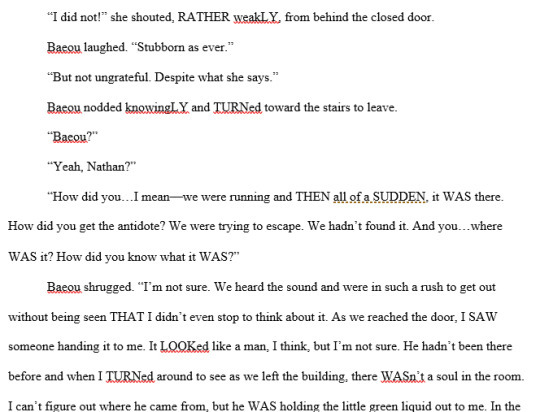
When I used this method with my most recent WIP, I was able to cut my word count from 105k to 93k without cutting any content whatsoever. It takes a lot of work and it’s pretty tedious but the results are amazing!

It wouldn’t be the English language without exceptions, would it?
Now, there is actually an important time for intentionally using any or all of the words on this list. You know when that is?
When it fits the character’s voice. - More on this in my next post!
24K notes
·
View notes
Photo

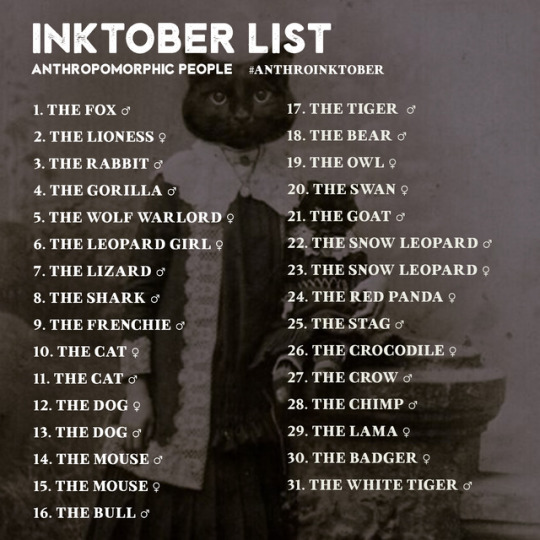
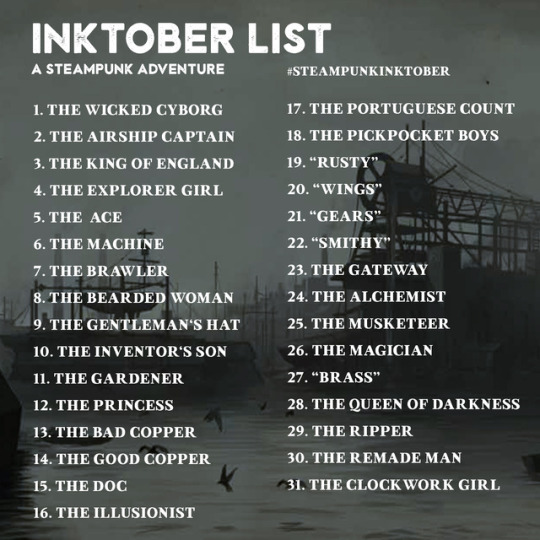
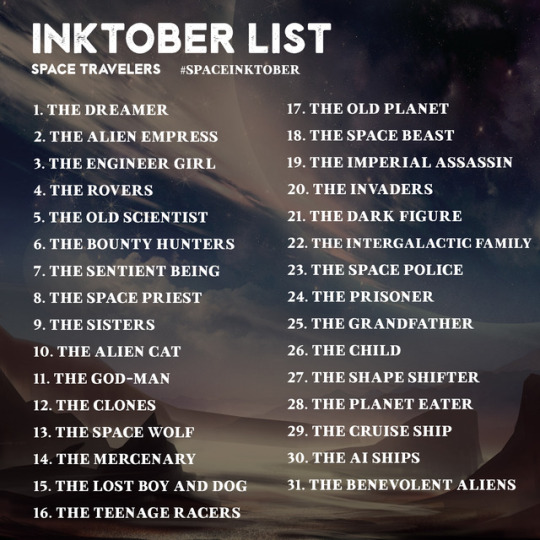
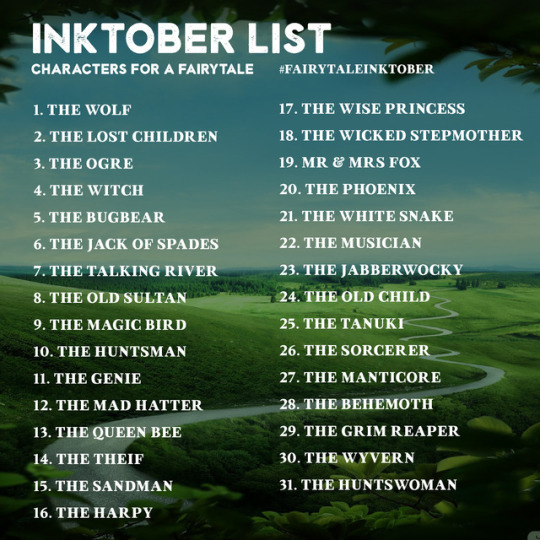
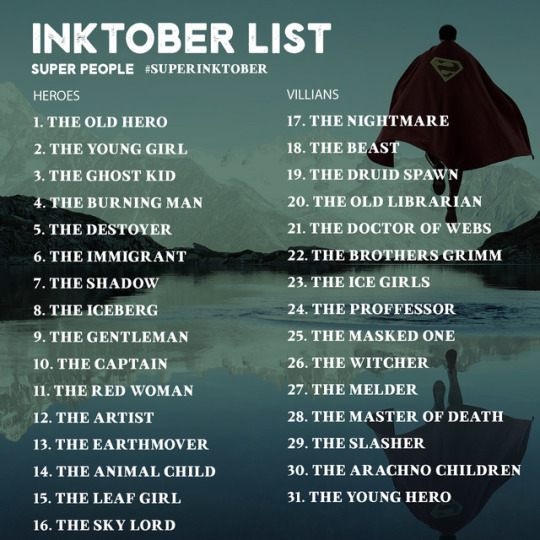
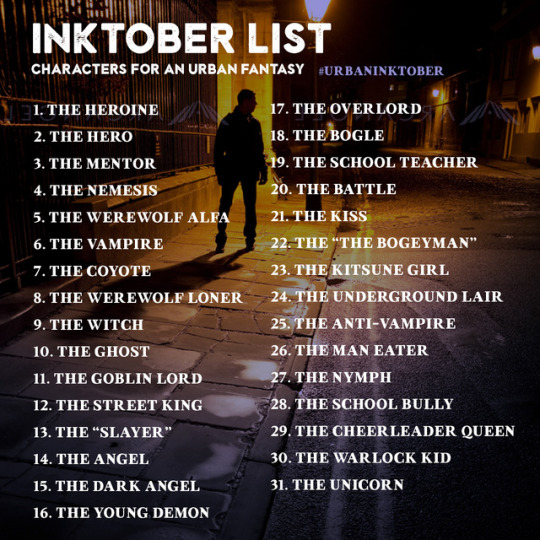
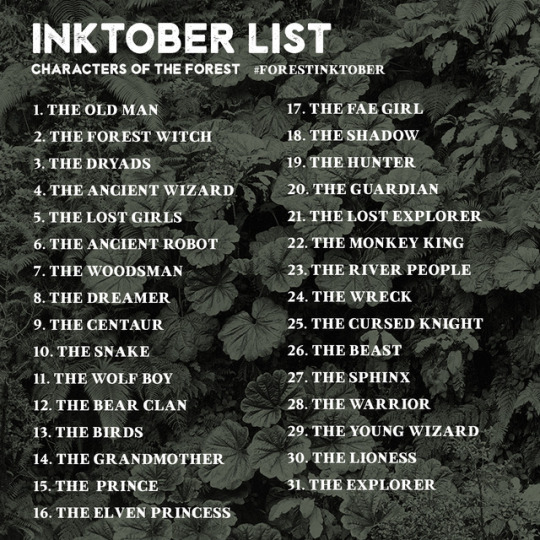
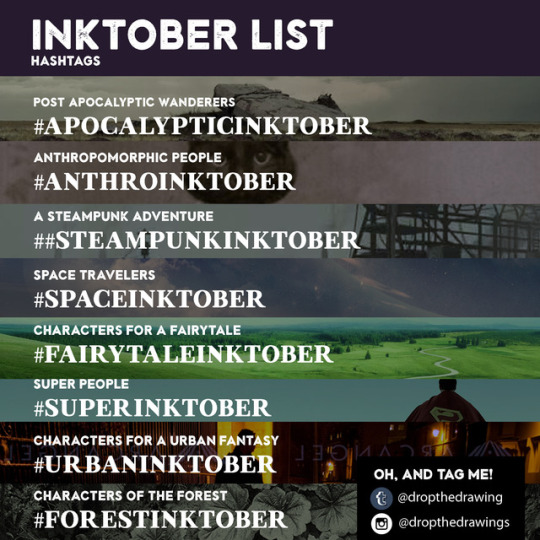
Preparing for Inktober 2017? #Hashtags now included
**The prompts are now updated WITH HASHTAGS!
I am too! And to get inspired, I have put together 8x Inktober prompt lists, to help us create something really cohesive and cool this October
Prompt lists:
- Post Apocalyptic Wanderers
- Anthropomorphic People
- A Steampunk Adventure
- Space Travellers
- Super People
- Characters for a fairytale
- Characters for an urban fantasy
- Characters of the Forest
Enjoy and share!
84K notes
·
View notes
Text
+40 Pixel Art Tutorials
A growing collection of animated Pixel Art Tutorials by Pedro Medeiros (@saint11) of Studio Miniboss (they previously worked on TowerFall and are currently working on Celeste and Skytorn)
All +40 Pixel Art Tutorials can be found on blog.studiominiboss.com/pixelart (10 Pixel Art Tutorials are posted below)

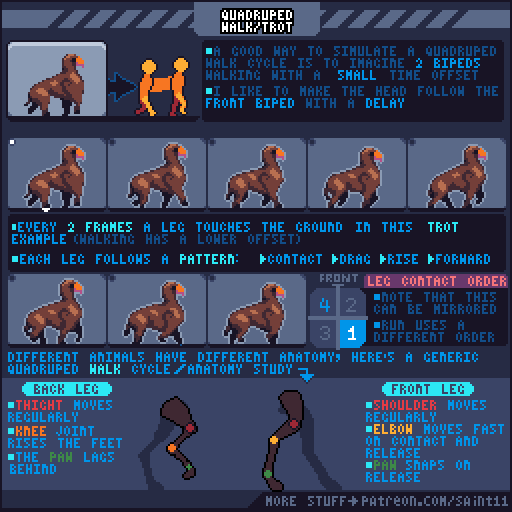


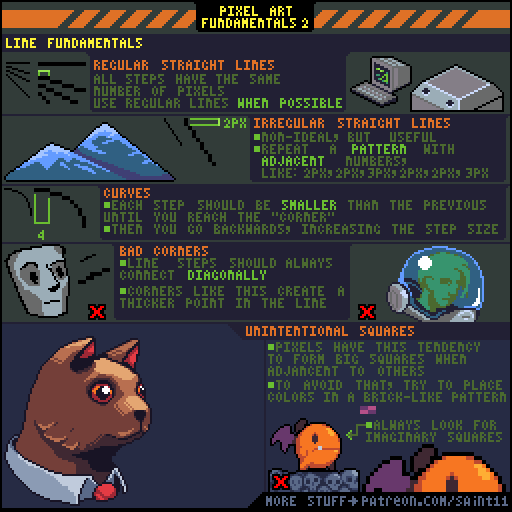



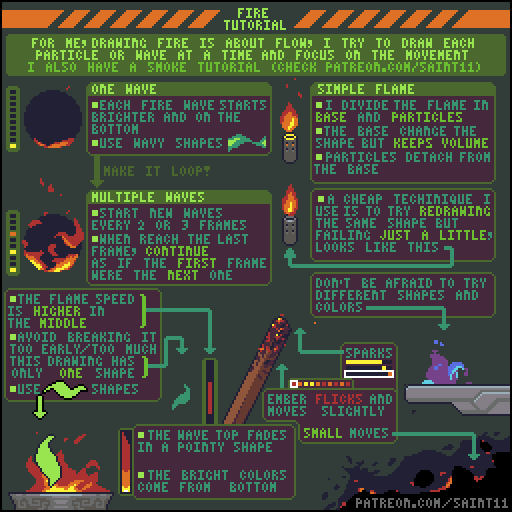
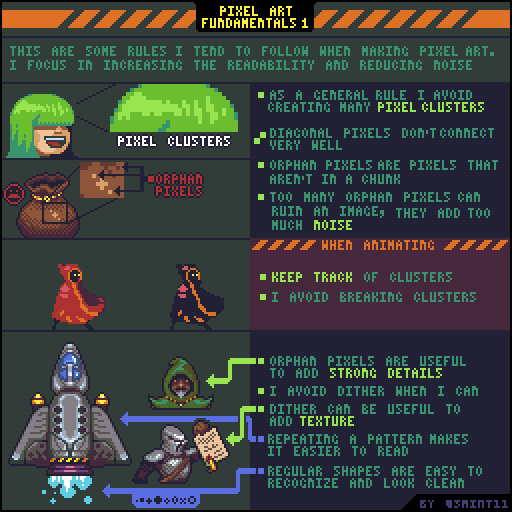
92K notes
·
View notes
Photo

Vladimir Kireev (1984) Autumn 2016
Владимир Киреев (1984) Осень 2016
30K notes
·
View notes
Photo

Dungeon Meshi is good and you should read it
220 notes
·
View notes
Video
tumblr
I did a bakuthing
13K notes
·
View notes
Text
Tricks and tips!
Collected in the past 18 months. Hope someone will find this useful :)
9 Advanced Baking Skills You Need to Know
10 Secrets for Baking Professional-Quality Cookies at Home
THE ULTIMATE KITCHEN CHEAT SHEET
How to Convert a Cake Recipe into a Recipe for Cupcakes
Your Go-To Field Guide to Cake Serving Sizes
How To Convert A Recipe Into A Pressure Cooker Recipe
12 TIPS AND TRICKS TO MAKE YOU A BETTER HOME COOK
Baking Basics: Weighing Ingredients
How to Turn Any Alcohol You Like Into Tasty Frozen Popsicles
150+ Life Hacks That Will Make Your Life Instantly Amazing!
Baking Basics: 5 Mistakes to Avoid When Preparing a Recipe
This Illustrated Guide Will Come in Handy When Making Candy
How to Master 5 Basic Cooking Skills That Everyone Should Know
5 Small Tips That Will Change the Way You Bake
Help! 🚒
Baking Basics: How to Cut Butter Into Flour
Cake Making Timeline: How Long It Takes to Bake Cakes & Cupcakes
Beginner Basics: How to Use a Piping Bag
Your Most Common Bread-Baking Problems — Solved!
How to Soften Butter Quickly: 5 Popular Methods Put to the Test
Common Buttercream Problems (And How To Fix Them)
6 Common Cupcake Problems (+ How to Avoid Them!)
Common Cookie Decorating Problems + How to Avoid Them
What to Do With Stale Bread: 12 Creative Ideas
How To Properly Salt Your Pasta Water | Gimme Some Oven
Tips for Baking with Yeast
10 Ingenious Tricks for Cheesecake Success
10 Ways to Finish Up a Jar of Peanut Butter
The Secret to Reheating Pasta at Work
The Secret to Getting the Right Royal Icing Consistency
Secret to the perfect pancake described mathematically
Pizza dough sticking to the wooden pizza peel
How to prevent your cheesecake water bath from leaking - Life Love and Sugar
Clean Up Sticky Dough Easier by Using Cold Water
Know your food 🤓
How to Cook Quinoa in the Instant Pot
HOW TO COOK AND EAT AN ARTICHOKE
How To Cut A Melon (The Different But Smart Way)
HOW TO COOK DRIED BEANS – THE OFFICIAL GUIDE
How to Measure Flour - Bake or Break
What Is an Egg Wash + Why Do I Need One?
How to Chop and Slice an Onion (video) » Fearless Fresh
The Many Purposes of Eggs in Baking
Keeping Avocado Fresh: A Complete Guide
Types of Gluten-Free Flour for Baking - The Craftsy Blog
BEST COOKING OILS: HOW TO CHOOSE THE RIGHT OIL
Baking Basics: Vanilla Beans 101
Easily Identify Edible Flowers With The Help of This Graphic | Lucky Peach
Baking Basics: Common Baking Substitutions
Let’s Get Frying: Everything You Need to Know About Frying Food
Baking Basics: Baking Soda vs. Baking Powder
Your Guide to the Strange World of Alternative Flour
The Best Way to Cook Different Cuts of Beef, in One Chart
Baking Basics: Cocoa Powder 101
Baking Basics: Flour 101
5 TIPS FOR BAKING WITH YEAST + 5 MUST TRY YEAST RECIPES
Let’s Talk: Egg Size & Why It Matters
How to Cut a Mango in 3 Simple Steps [Infographic]
How To Make Shredded Chicken
Small But Mighty: How to Cook Shrimp
This Is Why Your Recipe Uses Cocoa Powder Instead of Chocolate — Tips from The Kitchn
How to Cook Rice Properly: 5 Easy Methods
A New Baker’s Guide to Choosing the Right Kind of Flour
The Best 5 Oils For Your Kitchen - Read more at katheats.com
What’s the Difference Between Short-, Medium-, and Long-Grain Rice? — Ingredient Intelligence
A Complete Primer on How to Cook Artichokes With Ease
Technicals 🤷
How To Render Lard (and why you should use it)
How to Make Brown Butter Perfectly Every Time
Yes, You Can Zest a Lemon Without a Zester (Here’s How)
How to Bake Bacon Perfectly Every Time
How to Make a Strawberry Rose Step by Step
How to Cook Shredded Chicken
How To Make Candied Orange and Lemon Peel
How to Infuse Olive Oil With Your Favorite Flavors
HOW TO MAKE HOMEMADE VANILLA EXTRACT
How to Use the Floral Piping Tips Everyone’s Talking About
Baking Hacks: 5 Simple Specialty Flours Substitute to Make at Home - The Craftsy Blog
Let This Video Teach You How to Flip Crepes and Pancakes With Ease
How to Fold a Tin Foil Dinner
How to Make Evaporated Milk at Home
Learn How to Weave Bacon With This Video
Convert a Dutch Oven Recipe Into a Slow Cooker Recipe With This Rule
Sweets That Sparkle: How to Make Edible Glitter
HOW TO TEMPER CHOCOLATE
Magical Morsels: How to Make Homemade Chocolate Chips
How to blanch almonds
Kitchen and storing 🍴
Why the Person Who Cooks Should Also Do the Dishes
15+ Home Organization Ideas
The Best Way to Keep Cookies Fresh Longer
Baking Basics: Stocking Your Freezer with Make-Ahead Meals | Brown Eyed Baker
Baking Basics: Converting Pan Sizes
How to Organize Your Kitchen for Better, Faster Cooking!
How to Organize Your Spices…the Minimalist Way
How to Wrap Your Sandwiches for Better Eating on the Go
6 surprising foods you should keep in the freezer
How to Grow Herbs (in Pots)
SMALL BATCH BAKING TIPS: 3 PANS YOU NEED
20+ Cleaning Tips
The Best Oils to Care for Your Wooden Cutting Board
How to Store Muffins and Quick Breads
If you live in a rented apartment
What to Look for When Buying a Saucepan or Saucier
Designate a “Hurry Up and Eat” Shelf in Your Kitchen to Avoid Food Waste
Reading material 📖
Why We Use Room Temperature Ingredients for Baking
Why Are You Always Tired?
Why Do We Punch Bread Dough?
Here’s How Alcohol Gets You Drunk
The Ultimate Guide For Spiced Hot Chocolate
All About Baking With Sugar
Modeling Chocolate vs. Fondant vs. Gum Paste: What’s the Difference?
Smelly Cheese 101: Why Does Cheese Smell Bad? » Fearless Fresh
The Psychological Factors That Cause Food Cravings
Do you know where chocolate comes from?
Why Cocktails Are Served In Different Sizes and Shapes of Glasses
Food Science 101: What Is Sous Vide?
Why You Should Always Preheat Your Oven When Baking
Learn to code
What is the Difference Between Marzipan and Almond Paste?
How I Conquered My Fear of Cooking and Got Comfortable in the Kitchen
Follow for recipes
Get your FoodFfs stuff here
11K notes
·
View notes
Video
tumblr
my take on the yuri on ice opening
16K notes
·
View notes
Text
For anyone who wants a free pose-able human reference for drawing
The other day I came across this awesome program by accident (I don’t even remember what I was actually searching for, but on the several times I’ve looked for a program like this I’ve had no luck). It’s cool enough that I wanted to share it.

It’s called DesignDoll (website here) and it’s a program that lets you shape and pose a human figure pretty much however you want.
There’s a trial version with no expiration date that can be downloaded for free, as well as the “pro license” version priced at $79. I’ve only had the free version for two days so far, so I’m not an expert and I haven’t figured out all of the features yet, but I’ve got the basics down. The website’s tutorials are actually pretty helpful for the basics, as well.
Here’s the page for download, which has a list of the features available in both versions.
There are three features the free version doesn’t have:
Can’t save OBJ files for export
Can’t download models and poses from Doll Atelier (a sharing site for users; note that the site is in Japanese, though)
It can’t load saved files
The third one means that if you make a pose, save it, and close the program, you can’t load that pose/modified model later. You have to start with the default model. I found that out when I tried to load a file from the day before (this is why reading is important…). Whether saving your modifications (and downloading models and poses) is worth $80 is up to you.
But, the default model is pretty nice and honestly if all you’re looking for is a basic pose reference it should work fairly well as it is. Here’s what it looks like:

There’s a pose tag that lets you drag each joint into place and rotate body parts. The torso and waist can be twisted separately, and it seems like everything pretty much follows the range of movement it would have on an actual human.

Even the entire shoulder area is actually movable along with the joint! See, like how the scapular area of the back raises with the arm:

The morphing tag is one of the coolest features, in my opinion. It lets you pick and choose from a library of pre-set forms for the head, chest, arms, legs, etc. It has some more realistic body shapes in addition to more anime-like ones. Don’t like the options there? Mix a few to get what you want! Each option has a slider that lets you blend as much or as little as you want into the design.

So you, too, can create beautiful things like kawaii Muscle-chan!!

The scale tag lets you mess with the proportions and connection points of different joints. This feature combined with the morphing feature not only allows more body shape variations, but it also means that you can do things like make a more digitigrade model if you want. (The feet only have an ankle joint, but for regular human poses that’s all that you really need, so whatever.)

Or you can make a weird chubby alien-like thing with giant hands and balloon tiddies if that’s more your thing.

The ability to pose hands to the extent it allows is far more than I could have hoped for from a free program. Seriously, you can change the position of each finger joint individually, as well as how spread out the fingers are from each other. Each crease on the diagram below is a point of movement, and the circles are for spread between fingers.

And to make it a bit more convenient, there’s a library of pre-set hand poses you can pick from as well, and then change the pose from that if you like.
In both versions, you can also import OBJ files from other places for the model to hold, like if you wanted to have them hold a sword or something.
Basically, this program is awesome and free and you should totally check it out if you want a good program for creating pose references.
433K notes
·
View notes
Video
tumblr
IT’S FINALLY DONE!!
Here is my 4th Year Thesis Film, Starfall!! It’s about the moon rabbit who slacked off a bit too much and knocks the stars out of the sky! Narration done by Hime, and music composed by Hannah Simes!
600 notes
·
View notes











